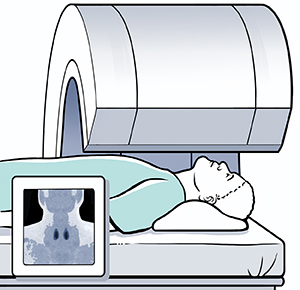Diagnosing a Parathyroid Problem
Your healthcare provider thinks you may have a parathyroid problem. They'll ask you about your health history and give you a physical exam. You may need to have blood tests. You may also need to have other tests, such as an imaging scan. Based on the results, your provider will work with you on a treatment plan.
Health history
Your healthcare provider will ask about your health history. Tell them about:
-
Symptoms you have, even if they seem minor
-
Health conditions you have, or had in the past
-
What foods you eat
-
The medicines, vitamins, herbs, and supplements you use. This includes both prescription and over-the-counter medicines.
-
Any allergies to medicines, foods, or other substances
-
Any family history of parathyroid or thyroid disease, cancer, heart attacks, strokes, diabetes, osteoporosis, kidney disease, or other serious long-term (chronic) illnesses
Physical exam
During a physical exam, your healthcare provider will feel your neck. They may also check other parts of your body to look for other causes of your symptoms.
Blood and urine tests
Certain tests are done to diagnose primary hyperparathyroidism and to rule out other causes of problems. The risk of related health problems, such as kidney and bone disease, is also evaluated. Tests may include:
-
Blood tests. Blood samples are drawn from a vein. These are checked for high levels of calcium and parathyroid hormone. The levels of vitamin D, magnesium, alkaline phosphatase, and phosphorus may also be checked. Your kidney function may also be checked with these blood tests.
-
Urine tests. Urine samples are taken over a 24-hour period. These are checked for high levels of calcium and signs of kidney problems. Urine testing could find a type of high calcium that runs in families and would not need surgery.
Imaging tests
Imaging tests can help show if parathyroid glands are enlarged. They can also check your bones for signs of calcium problems. You may have 1 or more of the tests below:
-
Bone density study. Scans of the hip, low back, or forearm are taken. This test measures the amount of calcium in the bones to check bone health.
-
Sestamibi scan. This is used to show enlarged parathyroid glands. The test can take up to 3 to 4 hours. During the test, a safe radioactive fluid is injected into the veins. This fluid helps make enlarged parathyroid glands show up clearly when a special camera is used.
-
Ultrasound. This test can also be used to show enlarged parathyroid glands. During this quick test, harmless sound waves are used to form pictures of the parathyroid glands. The pictures are then viewed on a computer screen.
-
CT scan. This test uses a series of many X-rays and a computer to form detailed images.
-
MRI. This test uses magnets and radio waves to form images without using X-rays. This test is used less often. But it can also be used to show enlarged parathyroid glands.
 |
| Sestamibi scan |
Online Medical Reviewer:
Chris Southard RN
Online Medical Reviewer:
Marianne Fraser MSN RN
Online Medical Reviewer:
Melinda Murray Ratini DO
Date Last Reviewed:
3/1/2024
© 2000-2025 The StayWell Company, LLC. All rights reserved. This information is not intended as a substitute for professional medical care. Always follow your healthcare professional's instructions.